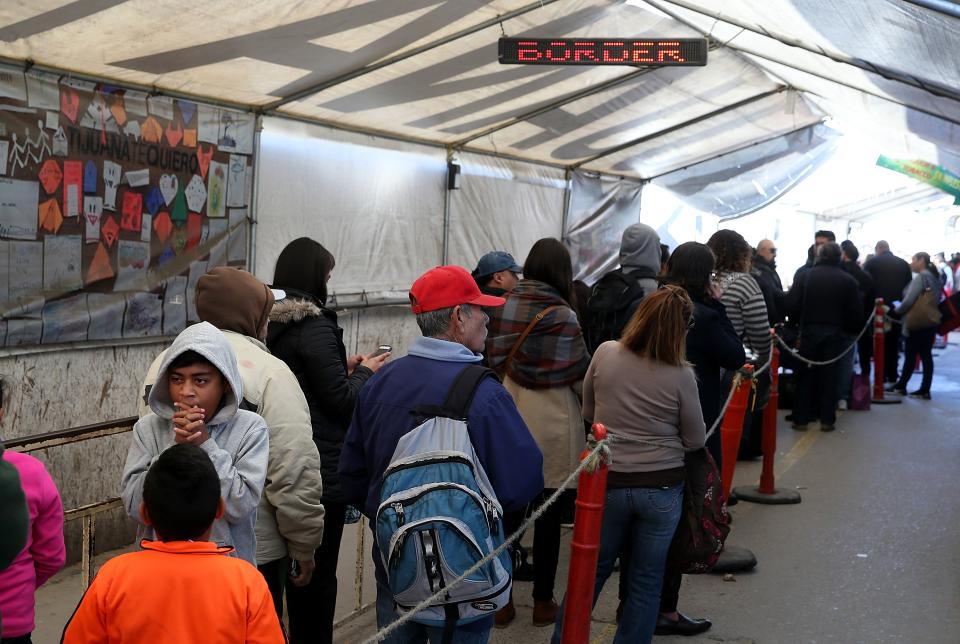A better way to spend Trump's border wall money

When he officially announced his plan to build a wall on the southwest border in late January, President Trump read the names of five parents in attendance whose children had been killed by people in the United States illegally. The border wall, Trump said, would “save thousands of lives.”
There’s actually no data on the number of Americans killed each year by undocumented immigrants, however. There are about 16,000 murders and 10,000 drunk-driving fatalities in the United States each year, and if undocumented workers were responsible for the same portion of those as the percentage of the US population they represent, that would total about 900 deaths. Some immigration experts think the number is smaller, since most people here illegally come not to commit crimes, but to lay as low as possible and earn money they can send to family members back home.
The wall Trump wants to build to cut down on such crimes will cost at least $21.6 billion, according to government estimates obtained by Reuters. Trump insists Mexico will pay for the wall, but any taxes imposed on Mexico are likely to be borne mostly by American companies and consumers. So here’s the question: If Trump spends $22 billion on his wall, will American taxpayers get a good return on their money?
First, some caveats: Foreigners sneak into the United States in a lot of places other than the southwest border. They walk or drive in from Canada, and arrive by boat and plane. Plus, fences, walls and other barriers already cover 650 miles of the southwest border, along some of the most heavily trafficked areas. The other 1,350 miles, where the Trump wall would go, track less hospitable terrain where few people cross in the first place. So even if it’s fully constructed, the Trump wall might not do all that much to halt illegal immigration.
So it’s reasonable to ask if there might be better ways to spend $22 billion. And if the goal is to save and protect American lives, the answer is possibly yes.
Spending more on drug treatment
The United States spends about $5 billion on drug treatment every year, which is tiny compared with money spent chasing and prosecuting drug dealers. If a fraction of Trump’s $22 billion in wall money were spent on prevention and treatment, it would probably cut US demand for drugs and save lives. “Drug abuse treatment is just crying out for more money,” says Martin Iguchi of the Rand Corp. “The bang for the buck in treatment is more than you’re going to get from any of these other approaches.”
About 55,000 Americans die every year from drug overdoses. Heroin accounts for about 13,000 of those deaths; cocaine, nearly 7,000. Trump himself has called the soaring number of heroin deaths a “tremendous problem” and pledged to do something about it.
Money spent on substance abuse treatment and prevention generally gets results. A landmark study from 2009 found that every dollar spent on preventing abuse in schools produced about $18 in benefits, through savings on law enforcement, jails, court intervention, medical care and family assistance, plus improved education. There are effective treatments for heroin addiction, but many addicts forego treatment because the cost isn’t covered by health insurance or they don’t have insurance in the first place. More subsidies for treatment would help more people get off drugs.
A few local treatment programs have been surprisingly effective at reducing the incidence of drug and alcohol abuse and compelling abusers to reform, such as the 24/7 program in South Dakota and Project Hope in Hawaii. Again, a fraction of the $22 billion Trump wants to spend on a wall would help other states and localities adopt similar programs and push drug and alcohol deaths down.
Nobody can prove that one type of spending in the future will save more lives than another type of spending. But drug treatment and prevention has been thoroughly studied, with results documented. There’s no real precedent for building a wall along the most remote parts of the southwestern border, by contrast. And traffickers are already adept at getting around barriers. “Most of the drugs are coming into the country through the transit points,” says Iguchi. “Most of it gets driven in.”
What treatment programs lack, of course, is the grandiose symbolism of a giant wall, which may be what Trump is really after. Trump has already shown a penchant for dramatic actions meant more for theatrical effect than anything else. His ban on immigrants from 7 Muslim nations, for instance, has been reversed by courts pointing out that the government hasn’t even said why such a ban is needed. And Trump has criticized American companies such as Ford and General Motors for building products in Mexico, even though they employ far more people in the United States. So Trump may get his wall, whether it’s effective or not. What taxpayers will get is another question.
Confidential tip line: [email protected]
Rick Newman is the author of four books, including Rebounders: How Winners Pivot from Setback to Success. Follow him on Twitter: @rickjnewman
